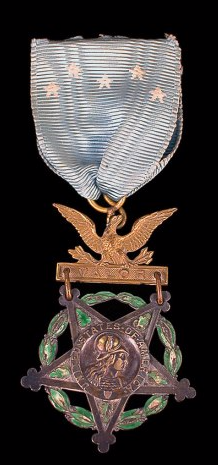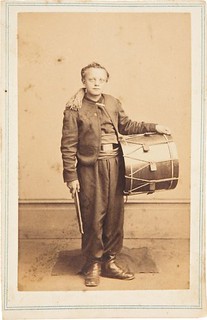
PREV ARTICLE
NEXT ARTICLE
FULL ISSUE
PREV FULL ISSUE
THE DRUMMER BOY'S MEDAL OF HONORHere's an excerpt from an article published May 20, 2017 on the O Say Can You See blog from the Smithsonian Institution. It was written by Kathleen Golden, an associate
curator in the Division of Armed Forces History. -Editor
The Medal of Honor is the highest award for bravery and valor that can be bestowed upon a member of the United States military. Modern military medals have lengthy citations that often vividly portray the sacrifice and heroism displayed by the recipients. At the Medal of Honor's inception during the Civil War, however, the curt citation often belied the extraordinary circumstances behind the award. One such citation is that of the Medal of Honor for Johann Christoph Julius Langbein: "A drummer boy, 15 years of age, he voluntarily and under a heavy fire went to the aid of a wounded officer, procured medical assistance for him, and aided in carrying him to a place of safety." J.C. Julius Langbein was born in Germany in 1845 but immigrated to the United States as a small child. He spent his young life in Brooklyn, New York, before joining in the fight between the Union and the Confederacy. At the age of 15—and with his parent's permission—Langbein enlisted with the Union Army's 9th New York Volunteers, also known as Hawkins' Zouaves, where he served as a drummer boy. He was young and small, with feminine features that earned him the nickname "Jennie" by the soldiers in his regiment. In January 1862 Langbein and his regiment joined General Ambrose Burnside's North Carolina Expedition.
For reasons that are not entirely clear, but perhaps due to Langbein lying about his age to enlist, his Medal of Honor wasn't approved until January 7, 1895. In 1905 he applied to the Record and Pension Office of the Adjutant General's Office and finally received his Medal of Honor based on his actions at the Battle of Camden more than 40 years before. To read the complete article, see:
 Wayne Homren, Editor The Numismatic Bibliomania Society is a non-profit organization promoting numismatic literature. See our web site at coinbooks.org. To submit items for publication in The E-Sylum, write to the Editor at this address: whomren@gmail.com To subscribe go to: https://my.binhost.com/lists/listinfo/esylum All Rights Reserved. NBS Home Page Contact the NBS webmaster 
|

